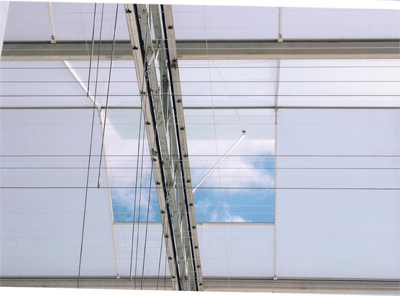
Features
Lighting
Structures & Equipment
Making the light decision
November 16, 2009 By Cees Vanden Enden
The time when you would simply order plastic at the lowest price – or
when building a glass greenhouse, order “just glass” – is behind us.
New developments are coming so rapidly that ordering your roof cover is
becoming a scientific task
The time when you would simply order plastic at the lowest price – or when building a glass greenhouse, order “just glass” – is behind us. New developments are coming so rapidly that ordering your roof cover is becoming a scientific task; considerations include what crop you are growing, which production period you are aiming for, and so on.
 |
|
| A greenhouse with an open vent covered with diffused glass. Advertisement
|
All these questions will influence your current and future choices. In the past, we developed plastic greenhouses as an economical and affordable alternative to the higher initial price of glass-covered greenhouses. We accepted the slightly lower light levels of the plastic. But even building a glass-covered greenhouse was a rather simple decision – you just ordered glass!
The last few years started a transition. We looked at the specific types of plastic or asked about the manufacturer of the glass, as this information had some impact on the light levels each material could produce.
The general rule of thumb that one per cent light equals one per cent production was still accepted by most people. However, it was found that in plastic greenhouses, with lower light transmission, production levels were being achieved that could compete very well with glasshouses with higher transmission rates. This added a new dimension in the search for higher light transmissions.
Clear glass in the past had light transmissions of 84 to 88 per cent; by producing low-iron level glass, this went up to 91 per cent. This was excellent for winter conditions, but we were still facing plant stress in the summer because of direct radiation on the plants. With these conditions, plastic coverings are doing a better job; because light through plastic is always a bit more diffused, plant stress will be delayed.
This knowledge prompted some people to look into diffused glass and some results were really eye opening. Production increases of five to nine per cent were realized, although the total light level decreased by four to six per cent and this was a factor in producing under low light levels in the winter.
 |
|
| Cees Vanden Enden
|
A NEW DIFFUSING TECHNOLOGY THAT COULD LIMIT THE LOSS OF LIGHT TO ABOUT FOUR PER CENT
Newly developed production techniques for glass are introducing new and very interesting options. One company is using an anti-reflection coating to limit the amount of light reflected back, thereby increasing the light entering the greenhouse by another four per cent. The same company is also introducing a diffusing technology that will limit the loss of light to about four per cent and in doing so will keep the light available to the plants at higher levels compared to the old types of glass.
Testing the glass, as was done in the past under a straight angle, was not reliable anymore. It was only reflecting the light penetration under circumstances that were seldom realized. TNO (Technological Research University in Holland) and the WUR (Wageningen University Research) have now developed a system that measures light penetration in a dome-shaped situation more representative of normal and natural circumstances. This testing is not only applicable to glass but with other greenhouse coverings as well. It is starting to be recognized as the new standard.
The expectation is that production will increase significantly despite the lower light transmission levels; diffusing the light lowers stress levels, delays the need for screening, and may eliminate the need for white-washing for a big part of the summer season. During the winter period, because of the treatments, it can increase the penetration of the light to the plants and increase the light efficiency by the plants.
It is difficult to make statements about the level of production increase without having tested this material, but expectations are high, varying from 10 per cent as a moderate level to more than 20 per cent suggested by some far more optimistic people.
INITIAL COSTS WILL BE SIGNIFICANT
In any case, this development has the potential to turn the industry upside down. The extra cost seems to be significant, but if this becomes mainstream, those costs will drop significantly. Payback times of between three and five years are reasonable to work with and could make this a worthwhile investment.
In plastics, we see similar developments and the choice will be driven by the needs of your crop.
When building a new greenhouse, all these developments will make your decision on what to build and with what specifications a difficult one. Developments are rapid at this time and many new products are entering the market, proven or not.
INVEST IN WHAT IS BEST FOR YOUR SPECIFIC GROWING REQUIREMENTS
Within the current economics, you cannot afford to make any costly mistakes. Take the time to develop your plans. Research the right combinations for you, as covering the greenhouse is only one facet of the new developments; energy efficiency and savings with closed and semi-closed greenhouses are also big factors. Have outside advice to help you consider all your options. The relatively small cost of advice can improve your chances of succeeding.
Cees Vanden Enden was born and educated in the Netherlands. He was a greenhouse vegetable grower there and in Canada for many years before launching HortiSource Consulting Inc. in 2003. • www.hortisource.ca , 403-637-2775 office, or 519-796-4327 (cell)
Print this page